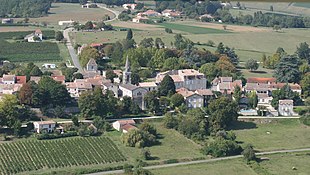Cotes de Duras
The Côtes de Duras are a wine-growing area in the northwest of the French wine-growing region Sud-Ouest in the Nouvelle-Aquitaine region .
location
The appellation named after the municipality of Duras is located about 30 kilometers southeast of Saint-Émilion and borders the Entre-Deux-Mers , Sainte-Foy-Bordeaux , Saussignac appellations and to the west on Bergerac . The vineyards, which have had the status of an Appellation d'Origine Contrôlée since February 16, 1937 , are cultivated by 221 winemakers in 15 municipalities. In addition to Duras, approved municipalities are Auriac-sur-Dropt , Esclottes , Sainte-Colombe-de-Duras , Saint-Astier , Loubès-Bernac , Soumensac , Saint-Jean-de-Duras , La Sauvetat-du-Dropt , Moustier , Pardaillan , Saint-Sernin-de-Duras , Savignac-de-Duras , Villeneuve-de-Duras and Baleyssagues .
Data
The cultivation area covers a total of around 2,200 hectares; Every year around 117,000 hectoliters of wine are produced, which is divided roughly as follows: 60% red wine , 36% white wine , 2% rosé wine and 2% sweet white wine.
Wine
Red wine and rosé are blended in the Bordeaux style from the grape varieties Merlot (60% of the cultivated area), Cabernet Sauvignon and Cabernet Franc (together 35%) and Malbec ( called Côt here ) . The minimum alcohol content is 10 percent by volume , the yield is limited to 55 hectoliters / hectare. Rosé wine may only be made using the Saignée method.
The dry white wine consists of Sauvignon Blanc , Sémillon and Muscadelle . In addition, must still Ugni Blanc are used. Its share must not be higher than 25% and in no case may it exceed that of Sauvignon Blanc. The Mauzac , Chenin Blanc (called here Rouchelin or Pineau de la Loire ) and Ondenc are only of theoretical importance . The minimum alcohol content is 10% by volume, the yield is limited to 60 hectoliters / hectare.
In sweet white wines, Sémillon and Muscadelle play a bigger role than Sauvignon Blanc. It is mostly a late harvest made from very ripe grapes. Noble sweet wines characterized by botrytis are the exception. The alcohol content is at least 10.5% by volume and the harvest restriction is 50 hectoliters / hectare.
Climate and soil
The region around Bergerac is subject to a strong oceanic influence with mild winters. Rainfall is particularly heavy in spring and late autumn. The summers, on the other hand, are mostly hot and dry. The weather is often stable well into November. Fog often forms in the Dordogne valley , favoring the development of noble rot . However, due to the distance between the Côtes de Duras growing area and the Dordogne, this only applies to a very limited extent.
On the orographic left bank of the Dordogne, freshwater limestone is embedded in molasse sand and marl . Together they form a real “layer cake”.
|
Average monthly temperatures and rainfall for Bergerac
Source: france.meteofrance.com
|
||||||||||||||||||||||||||||||||||||||||||||||||||||||||||||||||||||||||||||||||||||||||||||||||||||||||||||||||||||||||||||||||||||||||||||||||||||||
literature
- Jancis Robinson : The Oxford Wine Lexicon . Gräfe and Unzer Verlag, Munich 2003, ISBN 3-7742-0914-6 .
- Pierre Galet : Cépages et Vignobles de France . Lavoisier Publishing House, Paris 2004, ISBN 2-7430-0585-8 . (French language)
- Benoît France: Grand Atlas des Vignobles de France . Éditions SOLAR publishing house, Paris 2002, ISBN 2-263-03242-8 . (French language)
- Paul Strang: Vins du Sud-Ouest . Editions du Rouergue, Rodez 1997, ISBN 2-84156-054-6
Web links
- Official website of the Côtes de Duras
- Official website of the exchange between the Upper Palatinate town of Barbing and the town of Duras (Lot-et-Garonne)

